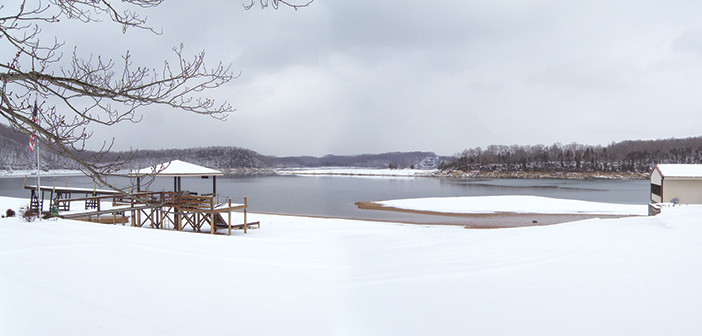Boone Dam repairs to take more than a year
By Scott Robertson

Boone Lake currently is 10 feet
below normal winter level. Inset: John McCormick Photos by Bill and Jeff Derby
The drawdown of Boone Lake will likely last significantly longer than one year, John McCormick, vice president of Safety, River Management and Environment said during a Johnson City news conference. During the first year, TVA will use a grout compound to fill in the voids in the natural limestone layer more than 100 feet below the earthen section of the dam. At the same time, McCormick said, the authority’s engineers, along with outside private-sector engineers, will be working on a permanent solution to the problem of water seeping from the lake above the dam through the earth to the river below the dam. Implementing that solution, whatever it may be, will likely take significantly longer. TVA officials say they cannot put a timetable on that implementation until they know what the exact process will be.
The geology of the region is the source of the problem. Most of Northeast Tennessee sits on an underground layer of limestone. Limestone can be dissolved, over time, by water. A layer of limestone pitted with voids created by this effect of water on stone is called karst.
When these voids collapse, they create sinkholes in the surface of the ground above. Such a sinkhole, measuring 4’x6’x10’ was found in the parking area of the dam control building in October. In most situations, a 240 cubic foot hole hundreds of feet away from the concrete dam would not be the impetus for a decision that would create a multi-year, multi-million dollar economic impact.
Boone Dam, however, is more than just the concrete construct people refer to as “the dam.” The entire earthen area from “the beach” north of the public overlook to the concrete dam is also part of the structure. The earthen portion of the dam holds Boone Lake from flowing around the concrete portion. It is under this earthen part of the dam that the sinkhole first revealed signs of voids in the karst, and became what McCormick called, “cause for alarm.”
When TVA officials discovered that water and sediment were entering South Holston River below the dam, the project became much more than just an effort to fill a sinkhole.
Since that time, TVA and private engineers have been working to determine the extent of the problem and prevent further damage.
While McCormick said he understands that some area residents have boats sitting in the mud right now, he cannot justify raising the lake level in order to let them retrieve their watercraft. His reasons are two-fold. First, there is the issue of safety. McCormick says TVA will not put more strain on a structure that is not functioning as it should. “The safety of downstream communities, industries, the public and our employees is our top priority.”
Second, McCormick added, the progress that has been made since October doesn’t need to be jeopardized by such action. “I do not want to do anything that is going to cause me to have to go back and do more work. We do not want to bring the water level up and have to go back down again.”
While McCormick was meeting the press, Rebecca Tuline, vice president for Resources and Land Management was meeting with marina owners to discuss options for maximizing lake usage during the drawdown. Should the length of repairs demand it, TVA may build additional access points into the lake. Currently only the Pickens Bridge ramp is long enough to reach the water.
TVA will host a community open house at Daniel Boone High School March 10 from 5 p.m. to 8 p.m. “We hope to hear from the public about addressing issues upstream,” Jim Hopson, public relations manager for TVA said. “They may have some better ideas than we do.”
The grouting – the first stage of the repair – will begin as soon as the mapping of the underground voids is complete. But the grouting will take a year to complete, McCormick said. “This is a slow, tedious process. This isn’t art. We are using science to map what it looks like under the earth. You find the void, then you try to find where the next void is. That will give us an idea of what our permanent repair plan will look like.”
At this point, the nature of that permanent repair is the question for which there is no readily available answer. There are, however, some known possibilities, McCormick said. “You could actually build another dam. You could build a concrete structure in the earthen dam and continue the concrete structure.”
It will just take time to determine the eventual course of action, McCormick concluded. “Our engineers and experts, who are some of the best in the country, are working with independent industry leaders to determine the best long-term repair options for the earthen embankment.”




